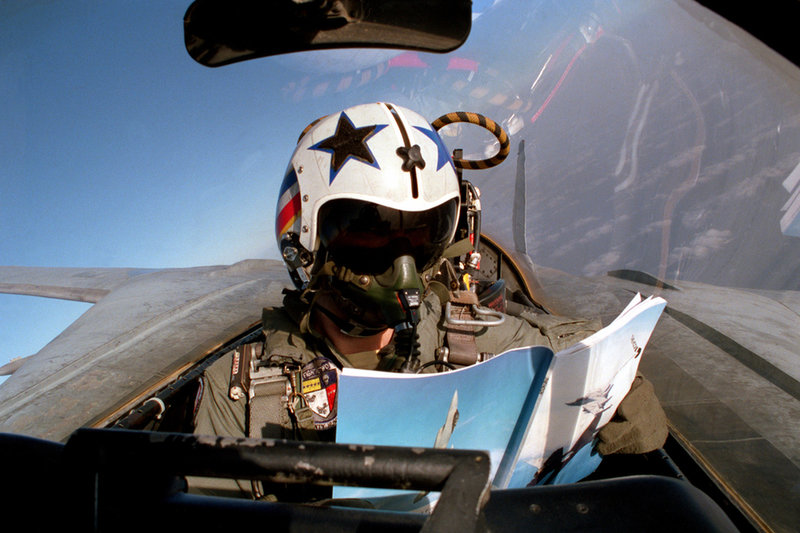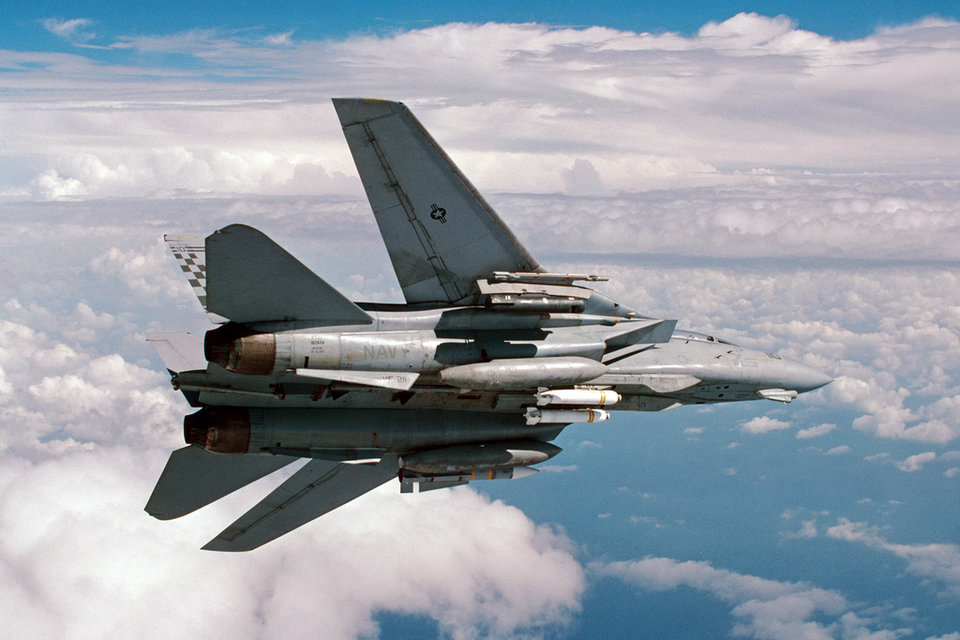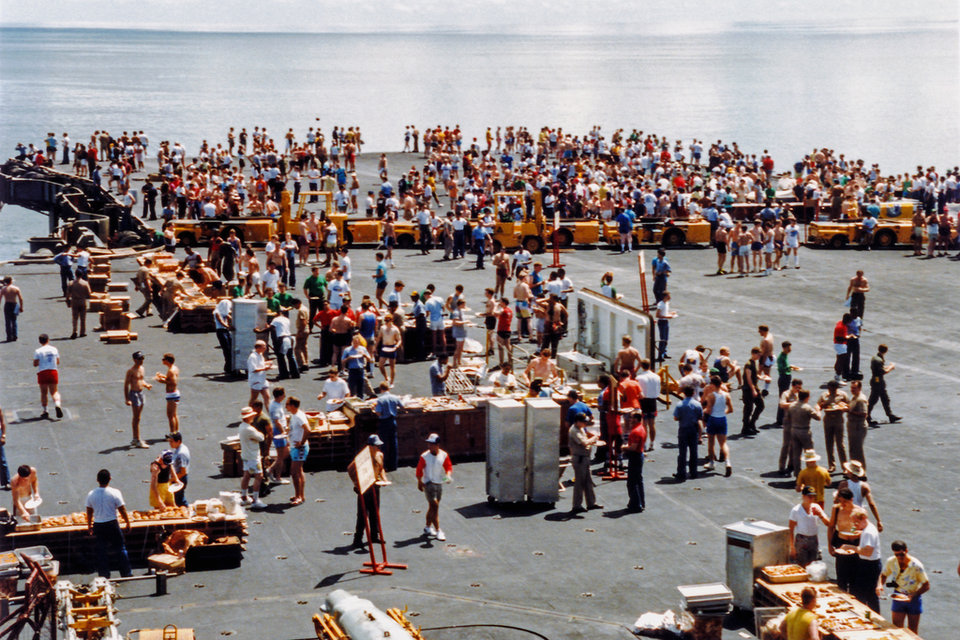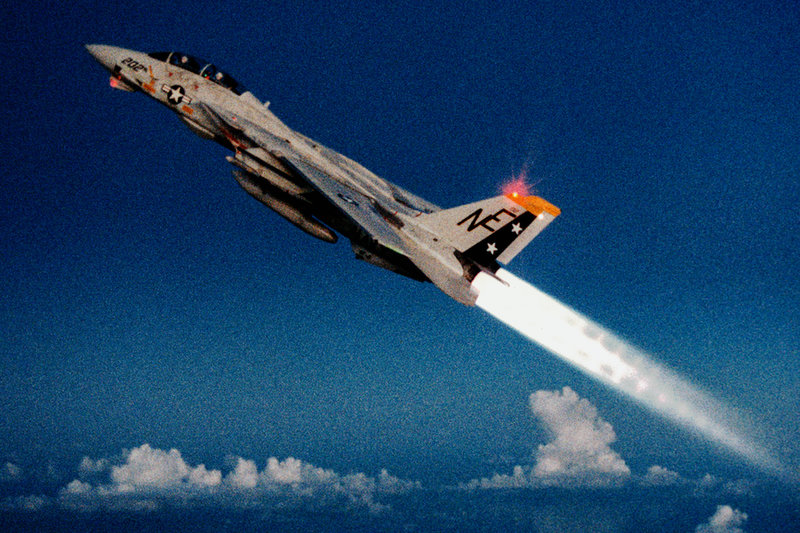Q&A | AIR
Beyond Top Gun: Dave ‘Bio’ Baranek on his career as an F-14 RIO
The release date for Top Gun: Maverick may have been delayed to next summer, but to whet readers’ appetite for tales of dogfighting, Berenice Healeyspoke to former F-14 radar intercept officer and Topgun training programme instructorDave ‘Bio’ Baranek.

// Image: Hours of boring patrols, a camera, and a little imagination led to this selfie Baranek took in 1989. He rigged a small tripod on top of his instrument panel and a remote release to capture the image, which has been used in many humorous memes on the Internet. Credit (all images): Dave Baranek.
Berenice Healey:
As well as having some amazing details of your experience, Tomcat Rio is very much a love letter to the F-14. What made the aircraft unique and so well-loved, and what were its shortfallings?
Dave Bio Baranek:
My earlier books were a little bit more objective, but I wrote this one for the F-14 audience – there are a lot of fans out there. Every aviator likes their plane; I was an F-14 guy. There's a small percentage who hate what they're assigned to, and that's too bad. The Tornado guys love the Tornado; I don't want to offend you, but the F-14 can outperform it in almost any arena.
Like the F-35, the Tomcat was a multi-mission airplane. Some people claim the Tomcat was designed as an interceptor and I hate when people say that; it was a multirole fighter. It was designed with all the lessons from Vietnam that they could fit into it, and the main lessons were visibility, manoeuvrability and the gun.
The F-14 I flew was the F-14A which was the original version. The biggest flaw was it had what were planned as temporary engines – [Pratt & Witney] TF30 engines – which was to do with navy funding, so the airplane was underpowered.
Another was that even though the radar had a lot of power and range and was very good for the time, the navy convinced Congress that it wasn't going to be very expensive and so they had to make a lot of compromises on it. The radar was designed in the 1960s and it was going to be on the navy version of that F-111 which was very old. When the navy came out with the F-14, they said, to save money, you will reuse these components. Well, they got what they paid for.
Fifteen or 20 years later when the F-14D came out, it had big engines and digital radar and a lot of other things. And it was the airplane that the navy should have had all along, but it came out late.
The biggest thing that bugs me was the navy had this thing called digital flight control system. It was a little computer box; it had a modest cost. People who flew with that said it changed the feel of the F-14 it for the pilot; it made it a more comfortable, more precise airplane, but they didn't put that in until 1998 or 1999, which was after I finished flying.

// Image: In one of Baranek’s squadrons, the pilots and RIOs used watercolour paint to camouflage their gloss grey F-14s in preparation for exercises. Later the navy would adopt low-reflectivity paint. This photo was taken over Southern California in 1988.
In your book you return to training at various points in your career. What is the importance of that?
One of the points I make in my book is the value of training, not only ‘school house’ training as in formal training programmes, but also in squadron training and the experience of flying a reasonable amount because I saw the value of that in my own performance.
When I came back to a squadron in 1996 after six years away, the level of professionalism was higher than I remembered and the level of performance in the airplane was better. And I have to credit the navy's establishment of the Strike Fighter Weapons and Tactics programme.
What qualities made you such a good RIO?
The thing that helped me was that I tried to be good. When I was out there flying over the Indian Ocean on a boring patrol or training flight, I was always playing with dials to adjust the radar, seeing what they would do and going to the limits, because I had a lot of time to kill. Not only that, but I’d ask the more senior RIOS in the squadron how did you get to be so good, and I would try to emulate them.
I had the opportunity to go to the Topgun school as a fairly junior Lieutenant. And that was very valuable training and experience. When I went back as a Topgun instructor, the workload was incredibly hard. Last year, we went to the Topgun 50th anniversary reunion and the new instructors told us the workload’s very hard, but that's what it takes to maintain the level of expertise that Topguns are known for anyway.

// Image: In the 1990s the F-14 added air-to-ground capability to its mission set. This photo shows a Tomcat with the LANTIRN precision targeting pod (right wing station) and two cluster bombs (belly) during Operation Southern Watch over Iraq in 1997.
You talk about the risk of complacency, however experienced aviators are, in your book. Can you tell us more about that?
I was flying with Hooter [F-14 pilot John ‘Hooter’ Schreiber]; he and I had both happened to have seen this article in the naval aviation safety magazine, which is called Approach. It had this interesting graph showing how the mishap rate went down and down as your experience increases, and then it climbed and then it went down again. They said it was down to complacency; people become comfortable and confident and they start to relax about some of the basics.
Hooter spotted that in our performance in just two flights over two days, and when he said that it got both of our attention and probably saved us from more mistakes.
You flew from several aircraft carriers. How does the experience differ?
My first deployment was on the [USS] Constellation, that's in the previous book and my second deployment was on Ranger. In this book, I did two deployments on Ranger and one on Nimitz; my five deployments were Constellation, Ranger, Ranger, Ranger, Nimitz.
[Flying from the different classes is] quite different. Part of it is mental; when you are training as a pilot or RIO you do hundreds and hundreds of ‘carrier’ landings at a base. There's a small rectangle painted on the airfield; you can see them if you call up an airfield on Google Earth. There's an landing signal officer standing by the runway and he's grading every one of those passes for the carrier learning practice.
So you've done hundreds of them; it's the same lens on the side of the runway, it's the same size painted on the runway, but you have your peripheral vision. Then you go out to the carrier and you see this little thing; when you're a mile away it's like this big [Baranek indicates an inch] and you're going, “We're going to land on that?”

// Image: Baranek makes a point to put the flying in context, with stories and photos such as this one showing a ‘steel beach picnic’ on the USS Ranger in the Indian Ocean in 1989. It was chance to give the crew a break after intense operations.
What was the mental shift like going from training to being deployed in the Strait of Hormuz?
You felt like you're ready, you're excited to go over there. At that time in the 1980s we were not being shot at. We figured if we would go into combat everyone would have been nervous. It didn't seem likely, but I felt like we were ready; we planned for it and we all said I'll survive, because it was not imminent.
Years later when I went back and I did [Operation] Southern Watch we were flying over hostile Iraq. Even though they weren't shooting at us, there was a bit more tension because there had already been the first Gulf War so we knew you know there could be a shooting war here. You have confidence in your systems and your mates.
You initially wanted to be a pilot, but your eyesight wasn’t good enough. What would you say to anyone who's thinking about becoming an aviator and maybe hadn't considered another flying role, like WSO?
I'd say go for it. I think back to myself and I had difficult times especially along the way to college graduation, commissioning and all that where I could have given up and said oh I flunked out or I didn't make it or it looked like it was going to be hard. But I stuck with it and I got through it. I understand it's not for everybody, but if somebody wants to do this, I would say they should make the effort.
Second, I knew plenty of people who said, “If I can't be a pilot. I don't want to be in the plane”. That's fine, that's their opinion. But for me, there was no chance of me being a fighter pilot so I was very happy to be a RIO because it got me in this incredible fighter and the more I learned about it, the more I thought, wow, this is really cool.
There are WSOs and in one of the Navy Carrier Wing Compositions, one of the four squadrons is F-18Fs, so there are still some seats for WSOs in fighters and of course the Growler jammer airplane. There are still some airborne seats for non-pilots and those are great jobs and it's a great mission and a great life. The more I learned about it, the more I liked it. It was a lot richer than I could have even imagined.

// Image: Baranek captured the F-14’s impressive afterburners in this image he took one evening in 1989 over the South China Sea, off Vietnam. He likes the grain in the photo because it indicates the fast film he had to use.
Dave ‘Bio’ Baranek flew the flying aerial sequences in the original 1985 Top Gun film and served as dialogue advisor. His role as radar intercept officer (RIO) – the air flight officer involved in air operations and weapons systems – in the F-14 Tomcat was the same as that of Goose in in the film. In current aircraft, that role is now known as a weapons systems operator (WSO, pronounced wizzo).
Baranek’s third book, Tomcat Rio: A Topgun Instructor on the F-14 Tomcat and the Heroic Naval Aviators Who Flew It, offers an unparalleled insight into the experience of flying in an F-14 in war and peace. The chapters spanning his career are interspersed with ‘intel briefs’, nuggets of insider information. In the one on callsigns we discover that Baranek’s callsign, Bio, is short for bionic, which his colleagues likened to his surname.